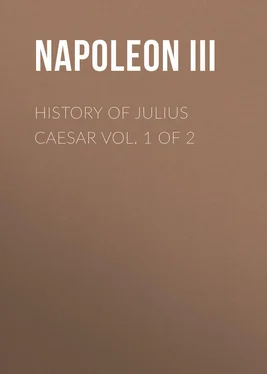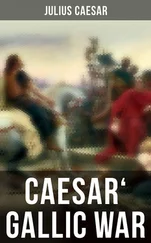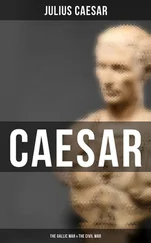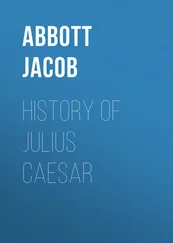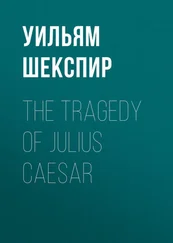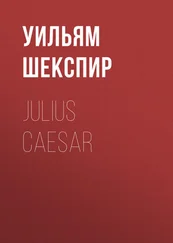Napoleon III - History of Julius Caesar Vol. 1 of 2
Здесь есть возможность читать онлайн «Napoleon III - History of Julius Caesar Vol. 1 of 2» — ознакомительный отрывок электронной книги совершенно бесплатно, а после прочтения отрывка купить полную версию. В некоторых случаях можно слушать аудио, скачать через торрент в формате fb2 и присутствует краткое содержание. Жанр: foreign_antique, foreign_prose, Биографии и Мемуары, на английском языке. Описание произведения, (предисловие) а так же отзывы посетителей доступны на портале библиотеки ЛибКат.
- Название:History of Julius Caesar Vol. 1 of 2
- Автор:
- Жанр:
- Год:неизвестен
- ISBN:нет данных
- Рейтинг книги:5 / 5. Голосов: 1
-
Избранное:Добавить в избранное
- Отзывы:
-
Ваша оценка:
- 100
- 1
- 2
- 3
- 4
- 5
History of Julius Caesar Vol. 1 of 2: краткое содержание, описание и аннотация
Предлагаем к чтению аннотацию, описание, краткое содержание или предисловие (зависит от того, что написал сам автор книги «History of Julius Caesar Vol. 1 of 2»). Если вы не нашли необходимую информацию о книге — напишите в комментариях, мы постараемся отыскать её.
History of Julius Caesar Vol. 1 of 2 — читать онлайн ознакомительный отрывок
Ниже представлен текст книги, разбитый по страницам. Система сохранения места последней прочитанной страницы, позволяет с удобством читать онлайн бесплатно книгу «History of Julius Caesar Vol. 1 of 2», без необходимости каждый раз заново искать на чём Вы остановились. Поставьте закладку, и сможете в любой момент перейти на страницу, на которой закончили чтение.
Интервал:
Закладка:
This fertility of Africa explains the importance of the towns on the coast of the Syrtes, an importance, it is true, revealed by later testimonies, because they date from the decline of Carthage, but which must apply still more forcibly to the flourishing condition which preceded it. In 537, the vast port of the isle Cercina (Kirkeni, in the regency of Tunis, opposite Sfax) had paid ten talents to Servilius. 263More to the west, Hippo Regius ( Bona ) was still a considerable maritime town in the time of Jugurtha. 264Tingis ( Tangiers ), in Mauritania, which boasted of a very ancient origin, carried on a great trade with Bætica. Three African peoples in these countries lay under the influence and often the sovereignty of Carthage: the Massylian Numidians, who afterwards had Cirta ( Constantine ) for their capital; the Massæsylian Numidians, who occupied the provinces of Algiers and Oran; and the Mauri, or Moors, spread over Morocco. These nomadic peoples maintained rich droves of cattle, and grew great quantities of corn.
Hanno, a Carthaginian sea-captain, sent, towards 245, to explore the extreme parts of the African coast beyond the Straits of Gades, had founded a great number of settlements, no traces of which remained in the time of Pliny. 265These colonies introduced commerce among the Mauritanian and Numidian tribes, the peoples of Morocco, and perhaps even those of Senegal. But it was not only in Africa that the possessions of the Carthaginians extended; they embraced Spain, Sicily, and Sardinia.
Spain.
III. Iberia or Spain, with its six great rivers, navigable to the ancients, its long chains of mountains, its dense woods, and the fertile valleys of Bætica ( Andalusia ), appears to have nourished a population numerous, warlike, rich by its mines, its harvests, and its commerce. The centre of the peninsula was occupied by the Iberian and Celtiberian races; on the coasts, the Carthaginians and the Greeks had settlements; through contact with the Phœnician merchants, the populations of the coast districts attained a certain degree of civilisation, and from the mixture of the natives with the foreign colonists sprang a mongrel population, which, while it preserved the Iberic character, had adopted the mercantile habits of the Phœnicians and Carthaginians.
Once established in Spain, the Carthaginians and Greeks turned to useful purpose the timber which covered the mountains. Gades ( Cadiz ), a sort of factory founded at the extremity of Bætica by the Carthaginians, became one of their principal maritime arsenals. It was there that the ships were fitted out which ventured on the ocean in search of the products of Armorica, or Britain, and even of the Canaries. Although Gades had lost some of its importance by the foundation of Carthagena ( New Carthage ), in 526, it had still, in the time of Strabo, so numerous a population that it was in this respect inferior only to Rome. The tables of the census showed five hundred citizens of the equestrian order, a number equalled by none of the Italian cities, except Patavium ( Padua ). 266To Gades, celebrated for its temple of Hercules, flowed the riches of all Spain. The sheep and horses of Bætica rivalled in renown those of the Asturias. Corduba ( Cordova ), Hispalis ( Seville ), where, at a later period, the Romans founded colonies, were already great places of commerce, and had ports for the vessels which ascended the Bætis ( Guadalquivir ). 267
Spain was rich in precious metals; gold, silver, iron, were there the object of industrial activity. 268At Osca ( Huesca ), they worked mines of silver; at Sisapo ( Almaden ), silver and mercury. 269At Cotinæ, copper was found along with gold. Among the Oretani, at Castulo ( Cazlona , on the Guadalimar), the silver mines, in the time of Polybius, gave employment to 40,000 persons, and produced daily 25,000 drachmas. 270In thirty-two years, the Roman generals carried home from the peninsula considerable sums. 271The abundance of metals in Spain explains how so great a number of vessels of gold and silver was found among many of the chiefs or petty kings of the Iberian nations. Polybius compares one of them, for his luxury, with the king of the fabulous Phæaces. 272
To the north, and in the centre of the peninsula, agriculture and the breeding of cattle were the principal sources of wealth. It was there that were made the says (vests of flannel or goats’ hair), which were exported in great numbers to Italy. 273In the Tarraconese, the cultivation of flax was very productive; the inhabitants had been the first to weave those fine cloths called carbasa , which were objects greatly prized as far as Greece. 274Leather, honey, and salt were brought by cargoes to the principal ports along the coast; at Emporiæ ( Ampurias ), a settlement of the Phocæans in Catalonia; at Saguntum, 275founded by Greeks from the island of Zacynthus; at Tarraco ( Tarragona ), one of the most ancient of the Phœnician settlements in Spain; and at Malaca ( Malaga ), whence were exported all sorts of salt fish. 276Lusitania, neglected by the Phœnician or Carthaginian ships, was less favoured. Yet we see, by the passage of Polybius 277which enumerates the mercantile exports of this province with their prices, that its agricultural products were very abundant. 278
The prosperity of Spain appears also from the vast amount of its population. According to some authors, Tiberius Gracchus took from the Celtiberians three hundred oppida . In Turdetania ( part of Andalusia ), according to Strabo, there were counted no less than two hundred towns. 279Appian, the historian of the Spanish wars, points out the multitude of petty tribes which the Romans had to reduce, 280and during the campaign of Cn. Scipio, more than a hundred and twenty submitted. 281
Thus the Iberian peninsula was at that time reckoned among the most populous and richest regions of Europe.
Southern Gaul.
IV. The part of Gaul which is bathed by the Mediterranean offers a spectacle no less satisfactory. Numerous migrations, arriving from the East, had pushed back the population of the Seine and the Loire towards the mouths of the Rhône, and already, in the middle of the fourth century before our era, the Gauls found themselves straitened in their frontiers. More civilised than the Iberians, but not less energetic, they combined gentle and hospitable manners with great activity, which was further developed by their contact with the Greek colonies spread from the maritime Alps to the Pyrenees. The cultivation of the fields and the breeding of cattle furnished their principal wealth, and their industry found support in the products of the soil and in its herds. Their manufacture consisted of says, not less in repute than those of the Celtiberians, and exported in great quantities to Italy. Good sailors, the Gauls transported by water, on the Seine, the Rhine, the Saône, the Rhône, and Loire, the merchandise and timber which, even from the coasts of the Channel, were accumulated in the Phocæan trading places on the Mediterranean. 282Agde ( Agatha ), Antibes ( Antipolis ), Nice ( Nicæa ), the isles of Hyères ( Stœchades ), Monaco ( Portus Herculis Monœcei ), were so many naval stations which maintained relations with Spain and Italy. 283
Marseilles possessed but a very circumscribed territory, but its influence reached far into the interior of Gaul. It is to this town we owe the acclimatisation of the vine and the olive. Thousands of oxen came every year to feed on the thyme in the neighbourhood of Marseilles. 284The Massilian merchants traversed Gaul in all directions to sell their wines and the produce of their manufactures. 285Without rising to the rank of a great maritime power, still the small Phocæan republic possessed sufficient resources to make itself respected by Carthage; it formed an early alliance with the Romans. Massilian houses had, as early as the fifth century of Rome, established at Syracuse, as they did subsequently at Alexandria, factories which show a great commercial activity. 286
Читать дальшеИнтервал:
Закладка:
Похожие книги на «History of Julius Caesar Vol. 1 of 2»
Представляем Вашему вниманию похожие книги на «History of Julius Caesar Vol. 1 of 2» списком для выбора. Мы отобрали схожую по названию и смыслу литературу в надежде предоставить читателям больше вариантов отыскать новые, интересные, ещё непрочитанные произведения.
Обсуждение, отзывы о книге «History of Julius Caesar Vol. 1 of 2» и просто собственные мнения читателей. Оставьте ваши комментарии, напишите, что Вы думаете о произведении, его смысле или главных героях. Укажите что конкретно понравилось, а что нет, и почему Вы так считаете.
